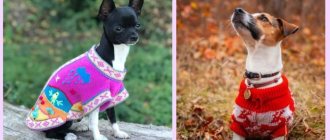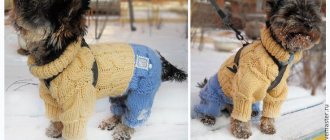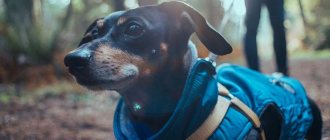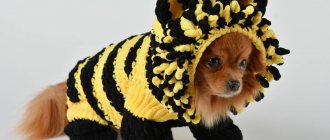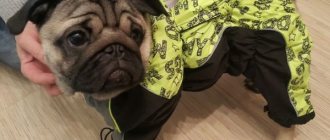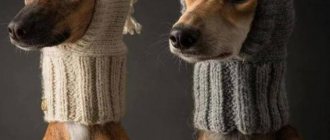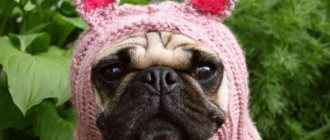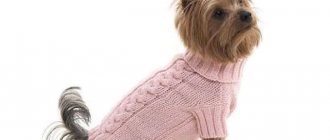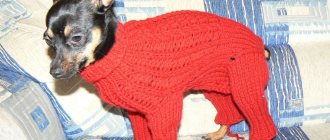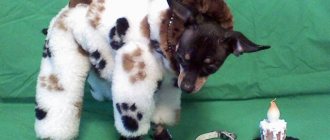Sweatshirts, vests, hats, socks for dogs, knitted with knitting needles. More than 10 ideas for beautiful and warm knitted clothes for dogs. Schemes and master classes.
Knitted dog clothes are ideal for small dogs with short hair. These clothes:
- Warm and comfortable.
- It can be easily knitted or altered from your own clothes.
- Dogs love these clothes - they don't interfere with their movement.
- Thin sweaters are suitable for summer weather; thick sweaters are for winter.
- It's cute and looks good on the dog.
How to knit a sweater for a dog for beginners: photos of the best models
If you know how to knit and purl stitches, this is enough to knit a sweater for your dog. First you need to decide on the model of the sweater, choose the appropriate threads for knitting. What threads are suitable for knitting a sweater for a dog?
Choose soft threads. If you take threads intended for knitting for small children, you can’t go wrong. Natural wool threads are warm, but can be scratchy. Check them before purchasing. To do this, you can put a skein of wool against your cheek; if you feel pricks from the wool, do not buy such threads.
Sweaters for dogs with patterns look interesting. But such models will be difficult for beginners.
Knitted Sweaters for Small Dogs
But you can also choose simple, but bright and interesting options for sweaters for dogs. This sweater is knitted with facial loops. What makes it interesting is the alternation of colored stripes.
Sweater - rainbow for dogs
Sweaters knitted with an elastic band, where threads of different colors alternate, create the impression of products with different structures.
DIY dog sweaters
It is not necessary to knit a dog sweater with complex patterns. After all, you can decorate it with applique.
Dog sweater with applique
You can buy such a sweater, or you can knit it. After all, then you will be able to accurately choose the appropriate size of clothing for your dog.
How to train your pet to dress up
Any animal does not like having things put on it. Therefore, it is recommended to accustom children to clothing from a young age. Light clothing is put on a small puppy for a short time so that he gradually gets used to it. Quite quickly the dog will understand that he is being dressed before a walk, and if the item is comfortable and convenient, the animal will not show dissatisfaction.
It is very easy to knit clothes for your Yorkie yourself; you can find various patterns and detailed tutorials on the Internet. It doesn’t matter whether you knit a jumpsuit for a bull terrier or another dog, the main thing is to choose the right threads and tools, and during the knitting process, take your time and check everything carefully.
How to properly measure a dog for knitting clothes?
If you are interested in how to properly measure a dog for knitting clothes, here are some tips for you.
To create a pattern, you will need to take the following measurements from your pet:
- The length of the back is indicated by the letter A in the photo.
- Neck circumference - indicated in the photo with the letter B.
- Chest circumference - indicated in the photo by the letter B.
- The girth of the front paw is indicated in the photo by the letter G.
- The circumference of the hind paw is indicated by the letter D in the photo.
For male dogs, you will need a measurement marked E - from the throat to the genitals.
How to correctly take measurements from a dog for knitting clothes:
Dog measurements for sweater pattern
The dog pattern is slightly different from the human pattern in that the belly piece is smaller in width than the sweater back piece. This is due to the fact that the dog’s paws are located close to the stomach. Therefore, the part on the tummy will be approximately 1/3 narrower than the part on the back.
How to make a pattern without resorting to complex calculations?
If your dog has old unnecessary clothes, cut them at the seams and use these pieces to make a pattern from paper. In this case, it is convenient to use unnecessary T-shirts for dogs. Just keep in mind that the pattern for a sweater should be a couple of centimeters wider in width than a summer T-shirt. The base pattern from an unnecessary T-shirt will need to be supplemented with sleeves.
How to make a pattern for a dog's sweater
How to correctly take measurements from a dog for knitting clothes and create a pattern?
- Divide the dog's chest circumference by 3.
- On paper we draw two rectangles, the width of one of them is 1/3 of the chest circumference and the second is 2/3 of the chest circumference.
- The length of the rectangles is equal to the length of the back.
- We set aside 1/3 of the neck circumference and 2/3 of the neck circumference on the pattern.
- Lower the shoulder line by 3 centimeters.
- Below the shoulder line, mark the half-circumference of the front paw.
- And the half-girth of the hind leg.
- The basic pattern for the dog's sweater is ready.
How to knit clothes for a small dog: creating a pattern:
Pattern for a dog sweater
We lower the shoulder line by 3 cm for the smallest dogs. To avoid mistakes, measure the distance from the neck circumference to the beginning of the armhole of the front paw with a centimeter.
Making a pattern for a dog sweater
The most popular sweaters for dogs are those that cover the dog’s lower back in a semicircle on the back and fall slightly below the dog’s “waist” on the stomach.
If you made a basic pattern, adjust it for a sweater with a semicircular back. To do this, measure the desired length of your sweater from the neck line. Place this point on the main pattern and make the bottom of the sweater semicircular.
How to knit clothes for a small dog: creating a pattern:
Simple Dog Sweater Pattern
The front paw sleeves for this sweater are rectangle shaped. The length of the rectangles is equal to the circumference of the dog's front legs. These parts are knitted separately from the front and back. All that remains is to calculate the knitting density and you can start knitting.
Knitted clothes for dogs - patterns and patterns
1:506 1:509
Our pets are so faithful, so obedient, so smart, let them also be smart and beautiful! Moreover, knitting for your pets is a great, incomparable pleasure!
1:860 1:867
2:1371 2:1378
Owners of small breed dogs are especially close to the topic of clothing for their pet!
2:1524 2:4 2:97 5:1611 5:6 5:62
You will need: 50 g of beige yarn, 20 g of brown and terracotta yarn (100% wool, 250 m/100 g), straight or circular knitting needles No. 2.5, crochet hook.
5:322 5:329
Knitting density: elastic 2×2 30 p. = 10 cm, stockinette stitch 25 p. = 10 cm, 40 r. = 10 cm.
5:473 5:480
Calculation of loops Take measurements from the dog and calculate the number of loops.
5:618
Neck girth - 21 cm (63 p. + 2 cr. p. = 65 p., round to 66 p., since their number must be a multiple of 3); 1/3 girth ~ 7 cm (21 p. + 1 p. for elastic symmetry 2×2 = 22 p.); 1/12 girth ~ 1.8 cm x 2 = 3.6 cm (11 p.) - the width of the armholes at the beginning of knitting.
5:1024
Chest circumference - 35 cm + 2 cm for a loose fit = 37 cm (111 p.); 1/2 girth (width of back and tummy) - 18.5 cm each (56 p.)
5:1237 5:1242
The distance from the withers to the middle of the back is 11 cm.
5:1332 5:1337
Armhole height : distance from the base of the neck to the end of the front paw + 1 cm = 7 cm (28 r.)
5:1492
Armhole depth: for small dogs 2 cm (6 p.). 1/2 chest circumference - 1/3 neck circumference - armhole depth = 18.5 cm - 7 cm - 4 cm (2 cm for each armhole) = 7.5 cm (18 p.); 18 p.: 2 = 9 p.; Therefore, when knitting the armholes, you need to add 9 stitches from each edge of the tummy and back.
5:1967 5:4
To find out how many rows to add loops, divide the distance from the base of the neck to the end of the front paw + 1 cm by the number of added loops: 7 cm = 28 r.; 28 r.: 9 p. = 3 r. This means that yarn overs should be made along the edges of every 3rd row.
5:423 5:430
Back/tummy
5:464
Using a beige thread, cast on 66 sts. Using a 2×2 elastic band, tie a collar 12 cm high, making stripes of the same width with dark brown and terracotta yarn. Cast off 11 stitches and knit 22 stitches. (tummy), cast off 11 stitches, knit 22 stitches. (back).
5:869
Turn the knitting over: knit 22 purls. (back), then take the thread from the second ball and knit 22 purls. (tummy). You can gather the loops of one piece onto a knitting pin and knit it later.
5:1212 5:1217
Next, knit the back and tummy 28 r. stitch, making yarn overs along the edges of each 3 rows. (9 times). The volume of the parts will increase by 18 stitches. Knit the first and last 3 stitches in garter stitch so that the edges do not curl. Then, along the edges of each part, dial 7 air. p. (armhole depth = 6 p. + 1 cr. p.). Now each piece has 54 stitches (22 stitches + 18 stitches + (2×7 stitches), and you need 56 stitches (18.5 cm). Add the missing 2 stitches when switching from satin stitch to rib 2 ×2, making 2 yarn overs at equal intervals.Using a 2×2 rib, knit another 4 cm, making colored stripes, like on the collar.
5:2180 5:6
Assembly Sew the sleeveless vest pieces together and use a crochet hook to create a fringe of dark brown and terracotta yarn on the collar.
5:259 5:266
7:1278 7:1285
8:1826 8:2 9:508 9:511
10:1017 10:1022
Clothes with a hood
10:1063 10:1066
11:1570 11:2 12:506 12:509
Knitted by adding and decreasing stitches in the right places.
12:629
We measure neck circumference Chest circumference Waist circumference Leg circumference Distance from the “collar” to the dog’s paws
12:843
Naturally, each dog has its own size.
12:928
We calculate the loops. The yarn is different. We cast on loops on knitting needles equal to the circumference of the neck.
12:1090
We knit a collar.
12:1125
After the collar, we divide the knitting into three parts. It depends where the fastener will be. If it is on the belly, then there are approximately 15 loops on the sides and the rest is on the back.
12:1422
The number of loops depends on the density of the yarn (threads). In every 2nd row, add one loop to the center of the sides.
12:1644
So we knit up to the paws. Before the start of the hole for the paws.
12:98
Next, the three parts are knitted separately. Approximately 8 cm in the center and 9 -10 cm on the sides.
12:261
These three pieces are then joined and knitted together. Approximately 3 cm. Then we begin to decrease the loops in the middle from the hole for the paws. Approximately two loops in every 4th row. And so on until the end of knitting. I get 35-36 cm from the neck to the tail, including the elastic band.
12:749 12:754
Well, the design is as your imagination dictates! It is tied with an elastic band on the armholes and straps using stocking needles. You can make holes for tassels after knitting the collar and stretch the cord with tassels, etc.
12:1133 12:1138
For girls, I knit the belly to the end of the fabric; for boys, it’s better to 8 cm from the armholes and close the loops. Continue the required distance only for the central part - the back. Everything is individual and needs to be measured. To sit beautifully!
12:1558 12:4
The hood can be knitted as a sock heel . Make it removable with buttons or ties.
12:175 12:182
Knitted sweater for dogs
12:236 12:239
13:745 13:752 13:759
14:1265 14:1272 15:1778 15:6 15:13 15:122
We knit these sweaters from the collar. Calculate the number of hinges for the gate. If it is high with a lapel, increase its length by 2 - 4 cm so that after sewing the product, the collar does not squeeze the neck. Also add stitches for symmetry, for example, when sewing the edges of a collar knitted with 1x1 elastic, 1 knit stitch and 1 purl stitch must be joined, otherwise the seam will be noticeable.
15:789 15:796
So that the sweater can be worn over the collar and at the same time fasten the leash without problems, make a hole in the collar for the collar ring. To do this, when knitting the penultimate row of the gate in the place where the middle of the back will be, close 3 - 5 loops in a row, and in the next row, cast on the same number of chain stitches. When the collar is ready, divide the knitting into two unequal parts: 1/3 loops for the tummy, 2/3 loops for the back. They can be knitted from two balls at the same time, or you can gather the belly loops onto a knitting pin and knit it later.
15:1776 15:6 16:588
The depth of the armhole depends on the size of the dog
16:670 16:675
For small dogs (Yorkshire terrier, toy terrier, chihuahua) it is 1 - 1.5 cm,
16:833
for medium-sized ones (poodle, dachshund, Jack Russell terrier, white terrier) - 2 - 2.5 cm, for larger dogs - 3 cm or more.
16:1042 16:1047
To find out the height of the armhole, measure the girth of the front paw, add 1 cm, calculate 1/2 of the girth and subtract the armhole depth multiplied by two. If you plan to edge the armholes with elastic, then increase their height and depth by 1 cm. After both parts of the sweater are ready, sew them: first sew the shoulder seams (sewing the edges of the collar), and then the side seams.
16:1705
For details on how to calculate loops for a sleeveless sweater, see the description of the sweater.
16:179 16:186 16:277
You can reduce the width of the back in two ways: 1. Smoothly: knit 2 loops together along the edges of the back in every second front row; 2. Sharp: knit 2 loops together along the edges of the back fabric in each front row.
16:652 16:657
The edges of the back, knitted with stockinette stitch, curl up and spoil the appearance of the product. To prevent this from happening, knit the back to the length of the tummy, knit the first and last 3 - 4 loops in garter stitch (that is, all rows of knit stitches).
16:1073
For any pattern, it is better to knit the last 1.5 - 2 cm of the back with an elastic band. Then the product will take on a finished look, and the back will not ride up. If the pattern has voluminous braids, then when switching to an elastic band, knit all the loops of the braids 2 loops together
16:1515 16:6 17:515 17:522
1 - 1/3 neck circumference; 2 - 2/3 neck circumference; 3 - the distance from the base of the neck to the front paw (this measurement is inaccurate and is used to calculate the approximate number of yarn overs along the edges of the parts); 4 - distance between the front legs + 2 cm (allowance for armholes); 5 - back width = (chest circumference + 3 cm) - (distance between the front legs + 2 cm); 6 - belly length = distance from the base of the neck to the middle of the abdomen or to the hind paw); 7 - back length; 8 - the height of the armhole, the girth of the front paw increased by 1 cm (or by 2 cm, if the girth is very small) - the depth of the armhole x 2; 9 - armhole depth = 1 - 3 cm (depending on the size of the dog). If you plan to edge the armhole with elastic, increase its height and depth by 1 cm.
17:1828 17:6
If the distance from the base of the neck to the beginning of the front paw (measurement 3) is more than 3 cm, then the vertical distance from the collar to the beginning of the armhole (b) may not correspond to the value of measurement 3, since it is inclined (a). That is, the actual number of rows will be less than the number that you get when calculating loops using a regular pattern measuring 10x10 cm. To make the correct calculation, knit the sample, making a yarn over at the end of the front rows, or calculate the yarn overs approximately: if measure 3 is equal to 3 cm, make 3 - 4 yarn overs, one from each edge of the front rows of the fabric, 4 cm - 5 yarn overs, 5 cm - 6 yarn overs, 6 cm - 7 yarn overs, 6.5 cm - 8 yarn overs.
17:1150 17:1157
18:1663 18:6
the simplest thing you can think of.
18:171
19:763
You will need: 100 g of brown melange yarn (50% wool, 50% acrylic, 280 m/100 g), knitting needles No. 2.5, brown buttons (5 pcs.), a needle with a wide eye.
19:1023
Knitting density: elastic band 2×2 26 p. = 10 cm, 28 r. = 10 cm, garter stitch 25 p. = 10 cm.
19:1174
Calculating the loops Take measurements from the dog and calculate the loops.
19:1300
Product length - 25 cm. Chest girth - 53 cm (137 p. - 1 p. for elastic band symmetry 2×2 = 136 p.) Neck girth - 30 cm (78 p. + 2 cr. p. = 80 p.) The distance from the base of the neck to the front paw is 7 cm (20 r.) The girth of the front paw is 20 cm; 1/2 girth - 10 cm, 1/6 girth (armhole depth) = 3 cm (8 p.), therefore, 136 p. - (8 p. x 2) = 120 p.; 120 p.: 3 = 40 p. (15 cm) width of the tummy and each shelf Armhole height: 10 cm - 3 cm (armhole depth) = 7 cm (20 p.) Strap (2 pcs.) - 25 cm = 62 p. .
19:2110 19:6
21:1020 21:1027 21:1034
Description of work Cast on 136 stitches and knit 11 cm (30 rows) with a 2×2 elastic band. Then knit 40 stitches (first front), close 8 stitches (armhole), knit another 40 stitches (tummy), close 8 stitches again (armhole), knit the remaining 40 stitches (second front).
21:1441 21:1446
Turn the knitting over and knit 40 stitches of the second front, then take the thread from the second ball and knit the tummy loops, then use the thread from the third ball to knit the loops of the first front. Thus knit 20 rubles. Then dial 8 air. p. over closed loops. Knit in a straight line 1 cm (3 rows). Next, in three steps, begin to decrease the loops: 136 sts - 80 sts = 56 sts; 56 p.: 3 = 18 p. This means that you need to subtract 18 p. at a time:
21:2161
1st row - 2×2 rib, 2 sts. every 7 p.; 2, 3, 4th rows - according to the drawing; 5th row - 2×2 rib, 2 sts. every 6 p.; 6, 7, 8th rows - according to the drawing; 9th row - 2×2 rib, 2 sts. every 5 p. Knit the remaining 8 p. in a straight line and close the loops. For the placket, cast on 62 stitches and knit 2.5 cm in garter stitch. On the other placket, make five buttonholes at equal intervals. Sew the trims to the front of the sweater. Sew buttons onto one of the strips. Quilt the collar from the inside with rubber thread in 2 - 3 rows.
21:937 21:944 21:986
(by shortening the length of the back, we adjust it to the size of your dog)
21:1107
As a rule, it is difficult to calculate a sweater for a taxi because... it has non-standard measurements..... the simplest calculation for you:
21:1347 21:1354
22:1864 22:6
23:512 23:519
This is such a wonderful sweater - very convenient to work with... let's start.
23:650 23:655
* So, to knit a sweater for a dachshund, we will need from 50 to 200 g of yarn (depending on the size of the dog), a set of double needles (5 pcs.) and circular knitting needles of 2 numbers, usually No. 3 and 3.5 or 4, depending on the thickness of the yarn.
23:1040
* We measure the circumference of the dog’s neck in the place where the collar is usually placed tightly and cast on the required number of loops on smaller knitting needles. We close the knitting into a ring and knit the required number of rows around the neck (in this example, the neck is knitted with a double elastic band)
23:1576 23:6 24:512 24:519
Next, we distribute the loops, trying on our neck on the dog. I took the same number of loops for the back and chest, 3 loops for the sleeves and 6 loops for the raglan lines (4 stitches of the braid and 1 purl loop on each side of it). I knit the sweater itself using stockinette stitch.
24:978
Next, we begin the increases for raglan - the back in every 6th row, the sleeves - in every 4th row, the last rows we add the back in every 2nd row:
24:1239 24:1246 25:1752 25:6
At the same time, we simultaneously decrease the loops for the breast between the legs.
25:121 25:128
26:636 26:643
Then we remove the loops of the back and sleeves onto knitting needles with fishing line (you can use a strong thread) and knit the breast in straight and reverse rows
26:873 26:880 27:1386 27:1393
This is necessary for a good fit of the sweater, since the chest in taxi clothes should be much longer and more voluminous than the back; in the process of knitting the chest, we add loops so that the chest and back meet at the elbows:
27:1784 27:6 28:512 28:519
For now we leave the loops of the sleeves on the knitting needles with fishing line:
28:618 28:625 29:1131 29:1138
We combine the loops of the chest and back, knitting the outer loops so that there is 1 purl between the halves of the braid. loop and knit the torso in a circle, if necessary, decrease the extra tummy loops to the waist:
29:1513 29:6
30:512 30:519 31:1025 31:1032
32:1538
something like that…….
32:36 32:43
Thread started by Victoria Savitskaya
32:103
Knitted clothes for dogs - how to calculate the knitting density and why you need to do it?
Knitting density indicates how many loops there are per 1 cm of knitted fabric. This value varies and depends on the following parameters:
- Thickness of yarn.
- Knitting needle numbers.
- The type of knitting, pattern that is used for the product.
- The knitter's skills, that is, whether she knits the fabric tightly or loosely.
For each new knitted product, the knitting density is recalculated. An exception may be if you have already knitted clothes for yourself or your dog with a certain yarn. Then you can rely on the density of knitting in previously knitted sweaters.
How to calculate the knitting density when knitting clothes for a dog?
Cast on 20-30 stitches on the knitting needles. Knit with the type or pattern that you will knit approximately 10 cm of fabric. Without stretching the canvas, measure how many centimeters of the canvas you have. When calculating, edge loops are not taken into account. Now, count how many loops there are per 1 cm of your product. For example, you got 12 cm, and you cast on 20 loops. We divide 20 loops of 12 cm, we get 1.6 loops per 1 cm of fabric. multiply the width of the dog sweater by 1.6.
Knitted shoes for small dogs
Knitted shoes are light and comfortable. It does not rub or hinder your pet's movements. At the same time, it does an excellent job of keeping the dog’s paws warm. With shoes on, your pet can stand on cold ground for a long time and remain healthy.
To ensure your boots last a long time, it is recommended:
- insert insoles made of thick fabric into the shoes;
- the sole is made of waterproof thick material;
- knit the rest of the shoes in a circle with yarn in the direction from the sole upwards;
- Strengthen your socks with a leather or nylon insert to prevent your dog from tearing your shoes with his claws.
Note! Strong threads are used to knit shoes. Any knitting style is suitable.
Miniature dog breeds need extra care, especially during cold season. The above detailed information will help you learn knitting for dogs without any problems. Tips on choosing styles and selecting yarn will guide you among the many options.
How to knit a dog sweater with knitting needles for beginners: diagram with description, photos of the best models
Photos of the best patterns for knitting for dogs
We begin work with the part that will be on the stomach. To the size you got on the main pattern, add a couple of centimeters for a loose fit, count how many loops you need to cast on and knit a rectangular fabric to the shoulder line. Now you need to decrease the loops. Decrease stitches by knitting two stitches together at the beginning of each row.
Finish decreasing the stitches after knitting 3 centimeters of the fabric. Having knitted the fabric to the armhole line, close the loops on the neckline, focusing on the diagram. Knit the open loops in the form of two triangles on two different knitting needles. You will need to knit these triangles by decreasing loops on both sides. We knit the sweater part on the back in the same way, decreasing the loops along the shoulder line.
How to knit clothes for a small dog: creating a pattern:
How to knit a sweater for a small dog?
How to knit a semicircular back that covers the back of a dog?
- Divide the number of loops needed for knitting by 2.
- Cast on this half of the loops on the knitting needles and knit the fabric, adding one loop from the beginning of each row.
- When you have all the stitches on your knitting needles needed to knit the back, stop adding and knit a straight fabric.
We knit the sleeves of the sweater in the form of rectangles. The sweater will be more beautiful if you sew an elastic band to the neck and bottom, which will need to be knitted separately.
Sweater for a dog: photos of the best models
What mistakes can happen when knitting?
- A pulled edge of the fabric can result from decreasing stitches if the stitches that are knitted two at a time are too small. It is better to make these loops larger than the main knitting loops.
- A pulled bottom of a sweater can result if the stitches on the knitting needles are too small.
- The neck of the sweater is too small and does not stretch. When closing the loops at the edge of the neck, make them larger than the loops of the main fabric.
- Sew the elastic to the neck with a non-rigid, knitted seam, which will allow the neck to stretch when putting the sweater on the dog.
And such knitted clothes made from soft green threads are perfect for blonde dogs.
How to knit a sweater for a dog with knitting needles for beginners - photo of the best model:
Delicate knitted clothes for gentle blonde dogs
Knitted and crocheted vest
Knitting a vest for a dog is quite simple, both knitting and crocheting. The length of the dog's back is divided by 10, then transferred to the pattern and added a few centimeters to the seams. In such clothes, it is better to fasten on the back, this will make it easier to put it on the animal. Patterns and knitting patterns can be found online, but vests are much easier to knit than overalls and sweaters because there is no need to knit the sleeves.
Note! When knitting, it is worth considering the size of your pet’s fur so that the finished product does not interfere with it or cause discomfort.
Vest for small dogs with knitting needles: diagrams, description
A simple but very comfortable vest for small dogs is knitted with an elastic band from two fabrics. Sew on both sides. The holes for the dog's paws are left unsewn.
Vest for a small dog
Vest for small dogs with knitting needles - diagrams, description:
The vest in the photo above is knitted with a 2 x 2 elastic band.
- Cast on 1/3 of the stitches needed for knitting. How to calculate the required number of loops is described in this article above.
- Tie a straight fabric with an elastic band. Its length corresponds to the desired length of the vest.
- Close the loops. When casting off the stitches, do not knit the last row tightly. It is better to make the loops in the last row as large as possible.
- One part of the vest is ready.
All that remains is to knit the back of the vest.
- Cast on 2/3 stitches on the needles.
- Tie another straight fabric with an elastic band.
- Its length is the same as the length of what you have already knitted.
- Close the loops.
All that remains is to sew the vest. It is stitched along the entire length of the fabric, except for the armhole. The dog vest is ready. It is not necessary to knit a vest with one type of thread. This is how interesting a vest for a small dog looks, knitted with contrasting threads.
Knitted vest for a small dog
Knitting such a vest begins with yellow threads. Then they switch to brown. The model is loose, as a shirt is worn under the vest. The collar is knitted separately with an elastic band 1 by 1. The collar is sewn to the vest using a stretch knitted seam.
Dog clothes
Knitting kit for a dog: jumper and helmet
When walking in windy weather, special attention should be paid to protecting your pet's ears and head. A hat and hood will help you cope with this task. The helmet hat does not fall off the head and does not creep over the eyes; it covers not only the top of the head, but also the neck. The hood provides additional insulation. To knit a jumper and a hat-helmet for a small dog, you will need:
- 200 g yarn;
- straight and double needles No. 2.5.
Important! Knitting is done from top to bottom.
Cast on 46 stitches on straight knitting needles and knit 2 rows in garter stitch. Then knit 20 rows with a 1×1 rib. Then they move to the front surface. In the first row, 3 loops retreat from the edge, in the second - 4 loops, in the third - 5 and so on, add 1 loop on both sides in each row 15 times. The total is 28 rows from the elastic band.
For armholes, 10 stitches in stockinette stitch (for the chest), 12 stitches are cast off (for the armhole), 32 loops in stitch stitch (for the back), 12 loops are cast off (for the second armhole), 10 loops in stitch stitch (for the chest) and knit a row separately on every part. Then knit through all the loops, restoring 12 loops of each armhole. In total, you should get 72 rows from the elastic band. At the end, knit 4 rows with an elastic band and close all the loops.
For the sleeves, cast on 28 stitches along the edge of the armholes on stocking needles and knit 18 rows in the round with a 1×1 elastic band, cast off all stitches.
To connect, the middle seam of the jumper is made, the collar is left unsewn.
For the helmet, cast on 86 stitches on straight needles and knit 12 rows in stockinette stitch. For ties, you need to close 14 loops at both ends in the 4th row from the beginning of knitting.
After completing the 12th row, you need to divide the fabric into 3 parts: 2 × 15 loops for the side parts and 28 loops for the top part. Next, knit 4 rows, decreasing 1 loop in every second row 14 times on both sides of the upper part of the fabric. Close all loops. A seam is made in the middle of the cap. Having laid a small fold, the hood is hemmed to the hat.
Jumpsuit for a small dog with knitting needles with raglan for a girl and a boy: diagram with description, photo
A jumpsuit for a small dog with raglan sleeves requires certain skills, as you will need to knit it with a smooth curve along the armhole line. Below is a diagram of such a jumpsuit.
Jumpsuit for a small dog with knitting needles with raglan for a girl and a boy: diagram with description, photo
Jumpsuit for a small dog with raglan sleeves Dog Clothes
The trouser legs are knitted separately in the form of rectangles. The length of these parts is equal to the circumference of the dog’s hind legs. Sew the trouser legs only along the outer edge. Pants are not sewn between the dogs' legs.
Striped jumpsuit for a small dog
Jumpsuit for a small dog with knitting needles with raglan for a girl and a boy: photo of a red jumpsuit.
Overalls for a girl's dog with raglan
Knitting blankets for dogs
Knitting blankets for dogs is easier than knitting blouses or overalls. But in terms of functionality and beauty, such products are no worse, and maybe even better, since they restrict the animal’s movements less. To knit a blanket, the length and width of the blanket when unfolded are sufficient. A blanket like the one in the photo below is knitted in the shape of a rectangle. It fastens with buttons at the front. The neckline is knitted by decreasing stitches.
Knitting blankets for dogs with knitting needles
Knitting blankets for dogs can be based on knitting triangles. Knitting begins from the bottom of the blanket. Alternate threads of different colors and decrease loops. Having reached the neck, the loops are closed. Assemble the blanket by tying four truncated triangles. In the model in the photo below, a hood is sewn to the blanket.
Knitting blankets for dogs with knitting needles
Variety of warm clothes
Clothes for dogs can be casual or formal. There are many types of clothing:
- overalls;
- blanket;
- sweater or jumper;
- dress;
- panties.
A knitted suit will give your pet a unique appearance.
For your information! The easiest product to make is a cape. To knit it you do not need to have perfect technique. These clothes are suitable for cool spring or autumn. In winter, more thorough insulation is still required in the form of overalls or a set of pants and a jacket for a dog.
In addition to basic clothing, hats of various styles and dog shoes are popular among animals.
Yorkie feels cozy and warm in a knitted hat
When choosing a model, you should pay attention not only to beauty, but also to practicality:
- the ties must be of sufficient length so that they do not come undone during walks;
- clothing should not hinder the pet’s movements;
- the collar should fit freely under or on top of the product;
- The length of the sleeves and panties should be shortened, otherwise the lower edges will quickly wear out.
Knitting dresses for dogs
Knitting dresses for dogs is interesting because to create a beautiful dress, it is enough to sew beautiful contrasting ruffles or pleats on the bottom of the blouse. The model below is wearing a Scottish style dress. Folds of checkered fabric are sewn on the back and sides, a pocket of fabric of the same color is sewn on the back.
Dog dress with pleats
And this dress is decorated with ruffles. The ruffles are tied with an elastic band, gathered and sewn on the bottom of the dress.
Delicate dress for dogs with ruffles
Knitted dresses for dogs are complemented with organza ruffles or knitted ruffles. Knitted ruffles are made using yarn overs. Having knitted the dress to the “waist line”, add about 1/3 of the loops and then knit the frill. Contrasting ruffles in several rows make the dress festive.
How to knit a dress for a dog
Necessity or whims of dog owners?
These are decorative dogs with short hair, a flattened muzzle and kind eyes. Their peculiarity lies in their affectionate nature, affection and devotion to the owner. When choosing a pug as a pet, you should understand that these dogs are in poor health, regardless of whether you have a boy or a girl, they require careful care and attention.
Most problems arise due to the brachycephalic structure of the skull, which complicates breathing and does not allow the body to effectively cool . The average temperature of a blenny ranges from 38°C to 39°C. When it increases or decreases by a few degrees, the pet begins to feel discomfort.
In the cold he shivers, and in the heat he becomes inactive and breathes heavily intermittently. Airlines even have a ban on bringing representatives of this breed on board. This is due to several deaths that have occurred. They physiologically cannot tolerate temperature fluctuations in the external environment and lack of oxygen.
If a pug's temperature reaches 42°C or more, he may die from heatstroke. When the thermometer reads 41 °C, the dog acutely feels an increased need for oxygen.
Therefore, pugs are walked very rarely in bad weather, and on cloudless frosty or summer days they try to protect them with clothing . A hat protects the head from direct sunlight, which can cause heatstroke in a dog in just a few minutes. To protect from wind and frost, a suit, hand-knitted or store-bought sweaters , T-shirts, pants, jackets, overalls, coats, and hats are . The paws are protected even by shoes.
After water procedures, to prevent sudden cooling, you should dry your pet thoroughly . In hot weather, walks are allowed for only 10 - 20 minutes with reliable sun protection; the rest of the day it is necessary to keep the dog indoors with the air conditioning turned on. Therefore, outfits for a pug are vital, which does not prevent owners from choosing them to their taste, making pugs real fashionistas.
How to knit a dog costume: ideas
Sets of clothes made from yarn of the same color look very cute on small dogs. An elegant dress for a small dog is complemented by a headband with pom-poms. The same pompom is on the dress itself.
How to knit a costume for a dog with knitting needles ideas:
Set of knitted clothes for a small dog
How to knit a costume for a dog with knitting needles ideas:
And these cuties seem to understand that they are the most beautiful creatures in the world. They pose for cameras no worse than famous show business stars.
The most beautiful sets of knitted clothes for small dogs
Purpose of clothing for dogs
Clothes for dogs were invented for a reason. It performs certain functions:
- protection. Initially, clothing and shoes were made from special waterproof materials so that dogs could walk in wet weather. Some items have rather narrow cuffs, which reduces the risk of parasites penetrating the dog’s skin;
- support. In some cases, after surgical interventions, dogs require special support devices, so special things have been created with similar functions;
- keeping warm. Despite the presence of fur, some dogs can freeze in the cold season. For winter walks, suits with insulation are provided to protect against the cold;
- beauty. Recently, costumes for dogs have been made from different materials, they are embellished and decorated. Owners want their pet to be the most beautiful and interesting looking.
If you wish, you can even knit a set of clothes
Important! Before choosing an outfit, you should think about the end goal - what exactly the suit is for.
How to knit a dog jacket with knitting needles?
Correctly selected yarn and a combination of several similar shades in one model can create very interesting blouses for dogs.
How to knit a blouse for a dog
How to knit a dog jacket with knitting needles?
If you have already decided on the color and style of the future blouse, make a pattern of your model out of paper and use it to knit an outfit for your dog. Dogs feel best in clothes that do not restrict movement. Sometimes, in their desire to dress up the dog and do its hair as best as possible, owners forget that the dog may be uncomfortable in beautiful outfits.
Blouses for dogs
How to knit a dog jacket with knitting needles - tips and step-by-step guide:
A small blouse (pictured below) for a small dog can be knitted without complex patterns or calculations. The blouse in the photo below is knitted without sleeves, and the wide belt with a button secures the blouse comfortably. But you will still need to calculate the number of loops. Approximately for a Chihuahua dog to knit the blouse in the photo below, you will need to cast on 32 loops.
- Start by knitting the neckline.
- Use 5 knitting needles as for knitting socks.
- Cast on the loops on the knitting needles and knit 10 rows with a 2 by 2 elastic band.
- Add 8 yarn over stitches at the bottom of the blouse. Knit 10 more rows.
- Where the cape ends, covering the dog's chest, the loops will need to be closed.
- Cast off 18 stitches and continue on 2 needles.
Now you are knitting a rectangle. Knitting can be decorated with braid patterns and other patterns that are familiar to you. If you knit this blouse with different threads you will get a colorful blouse. Close the loops at the end of the blouse. A wide belt with a button is knitted separately. Sew on with threads from the same yarn.
How to knit a blouse for a dog
How to choose by size?
When choosing an outfit, it is necessary to take into account many parameters , because the pet should feel comfortable in it, not experience discomfort from the presence of clothing, and receive the necessary protection from temperature influences . Therefore, the choice should be based on the following mandatory conditions when purchasing or independently sewing a wardrobe for your pet:
- The dog's chest and neck should always be free ; vests, overalls or sweaters should be chosen a little loose in this area, but not too much, in order to retain body heat.
- The animal should move as if it were not dressed at all; its movements should not be in any way constrained.
- Due to their high sensitivity to allergens, pugs react sharply to various chemical compounds or some natural ingredients, so the appropriate clothing material is selected. If rashes, allergies, irritation or other damage to the skin appear on your pet's body after wearing it, the item must be immediately removed and never used again.
- The weather is the main condition for choosing wardrobe items. Particular attention should be paid to the thermometer reading, the presence of wind, precipitation, etc. In summer, a hat is a must-have accessory on hot days.
- If the product is purchased and not made by hand, the pet must be measured well or it is better to take it with you to try it on in the store. If you don’t like something, it’s better to refuse the purchase and continue your search at another outlet.
- The presence of a hood in some models performs a double function - it protects the neck and head from the cold, and protects the dog’s sensitive eyes and ears from blows.
How to knit a hat for a dog using knitting needles?
Two options for dog hats:
- The dog's ears are open.
- The ears are covered with a cap.
The first option is more convenient for dogs, but suspicious owners probably think this option: “Will the baby catch a cold in her ears?” The second option covers the dog's ears, but is not very comfortable. There is a way out of this hopeless situation - a hat for dogs with ears.
Hats for dogs without ears and with ears
How to knit a hat for a dog using knitting needles: diagram:
Knitting needles No. 3 were used in this work.
- Cast on 53 stitches on the knitting needles, not counting the edge stitches. Knit five to six rows with a 1 by 1 elastic band.
- Measure the length of the resulting fabric with a centimeter or apply the knitting to the dog’s head. If everything matches the size, we knit the hat further.
- We find the middle of knitting - this is the 27th loop. 6 loops to the left and 6 loops to the right of the middle loop we knit the pattern.
How to knit a hat for a dog with knitting needles diagram
- We make a similar pattern and decrease the loops on the opposite side of the cap. If you fold the finished hat in half, the front and back parts will match.
- To get a shifted knit stitch, knit a knit stitch, then a purl stitch and swap them on the knitting needle. The front loop turns out to be shifted.
- Decorate the hat with a pompom.
How to knit a hat for a dog with knitting needles, diagram of a hat with ears:
- Measure the circumference of the dog's head and calculate the required number of loops for knitting. We knit the hat using stockinette stitch.
- The first rows are knitted in garter stitch. Black and orange threads alternate through the row.
- We knit the hat up to the ears. Then, not with the main thread, but with any contrasting thread, we knit 10 loops in place of one and the other ear. There may be more of these loops. It all depends on what size the “ears” will be.
- We do not secure the thread that was knitted in place of the ears. The ends of this thread, approximately 10-15 cm, hang freely. We knit the next row as with the main thread.
- We finish the hat by decreasing the loops or simply pulling the loops together.
- Let's move on to knitting the ears. Carefully unravel the contrasting thread that we knitted in place of the ears. 10 loops that turned out to be open are cast on one knitting needle.
- On the other side, we also cast on 10 loops on two knitting needles. To make the eyelet more voluminous, add 4 loops on the back side of the “ears”. They can be cast on with yarn overs. We knit on 3 needles.
- There are 10 loops on one of them and on two knitting needles, on the back side of the cap there are 7 loops each. We knit the ear with white threads on the side of the muzzle and in the color of the cap on the back side. While knitting, decrease one loop at a time at the beginning of the row. We sew white tassels on the ends of the ears.
A simple version of a dog hat with holes for the ears. The hat is knitted with an elastic band 1 by 1. The loops are closed on both sides under the dog’s ears. The hat is decorated with a pompom. The cap is tied with strings.
How to knit a hat for a dog - a simple pattern
And this interesting hat for a bunny dog can please both owners and guests.
Hat with bunny ears for dogs
Taking measurements
Then you can move on to the most important stage of work, which is taking measurements from the animal. If the dog has a restless character, then it may not be possible to cope with this work alone. It's better to find yourself an assistant. And it is also advisable to prepare some kind of treat for the animal.
Having chosen the most favorable moment, you can begin the process. The following measurements must be taken:
- chest circumference, which must be measured along the most voluminous part of the chest;
- neck circumference at its thinnest part;
- back length, which is measured from the point where the neck begins to the tip of the tail;
- paw height - the entire length of the limbs is measured from the armpit (this parameter is necessary only if the product is planned with sleeves);
- paw circumference, which is measured at the thickest point.
When taking measurements, it is important not to rush, since this determines whether the product will fit the animal or not. At the same time, we should not forget that to knit overalls you need to measure the distance between the paws.
How to knit socks for a dog with knitting needles?
Socks for a small dog with knitting needles. You can knit it like this:
- On five, like knitting needles, as they knit socks for people.
- On two knitting needles. In this case, the square for the sole and the rectangle for the walls of the socks are knitted separately.
Since the socks are small, knitting on five needles is inconvenient. The knitting needles keep falling out of the loops. Turning knitting by knitting 5 loops, which is how many are cast on each of the four knitting needles, is labor-intensive. The consolation is that you will have to knit no more than 15 rows.
VIDEO: How to knit socks for a dog?
How to knit socks for a dog with knitting needles:
Knitting dog socks on two knitting needles is less labor intensive than knitting with five knitting needles. Five spokes may fall out and become tangled. Below we will tell you how to knit socks with just two knitting needles from a square and a rectangle. To work you will need:
- Two knitting needles.
- Basic yarn for knitting socks. It is advisable that it be bright, so it will be easier for you to find the socks if your dog decides to take them off and put them in a place known only to him.
- Yarn of a different color to make ties.
First you need to knit a square that will serve as the “sole” of the sock. We cast on seven loops and knit seven rows, then finish. The end result should be squares like those in the last photo.
Knitting socks for dogs step by step
When the soles for the socks are knitted, we begin to knit the upper part. You need to cast on 21 loops . Then knit five rows according to the principle: knit row, then purl row, then knit row again, purl row. After this, we knit another eleven rows with an elastic band . The upper part of the socks is ready, we sew our two blanks together with a needle and knitting thread.
We knit the second part of socks for a small dog
All that remains is to make the laces. It is better not to make them from ordinary thread. Firstly, the thread will be stiff and will give, and secondly, such ties will definitely break. It is better to make laces from knitted thread. We cast on the loops and immediately finish knitting. This is what our socks with laces will look like.
Sock laces
Assortment of outfits for boys and girls
It is mandatory for a pug owner to provide his pet with:
- With a harness.
- A hat, panama hat or scarf.
- T-shirt.
- Scarf.
- Sweater.
- Vest.
- Sleeveless.
- Jacket and pants.
- Winter overalls.
- Coat.
Due to the peculiarities of the body structure of pugs, it is better for them to wear harnesses ; collars restrict the already problematic breathing during active games. This accessory is sold at any pet supply store. At home, it is easy to make such a device, having on hand a fastening ring, a soft ribbon, a lining for a safe touch to the dog’s body - nylon, synthetics, leatherette, tarpaulin or leather, from which the harness itself will be sewn.
Socks are most often made independently or chosen for children . When knitting, you should take into account the peculiarity of the foot, which resembles the shape of a human heel.
The sweater is based on patterns taken from a pet. When knitting or sewing yourself, it is better to measure the dog, draw the shape of the parts on paper, select the material and use your imagination. The purchase of a product must take into account the anatomy of a particular representative , so fittings in the store must be carried out carefully and carefully.
The most difficult to make is considered to be a jumpsuit . When taking measurements, you need to clearly understand how the final item will look like. Here you need to cover the paws, torso, neck, maybe with a hood, leaving holes for the natural needs of the dog. For fastenings, zippers are better suited than buttons, since they are much easier to handle and do not deteriorate as quickly.
Sewing or knitting a vest is the simplest of the above activities. Measurements are taken from the pet's chest, the neck is left free, there are no sleeves. It is better to make it from several elements, which makes it easier to fit the dog’s body during fitting before sewing.
How to knit shoes for a dog with knitting needles?
We bring to your attention interesting striped boots for dogs, which consist of two parts and are tied like real boots. If you are interested in how to knit shoes for a dog, you will definitely like this master class.
So, you need to connect two parts, approximately the same as in our diagram below. The paw sizes of all dogs are different, so the diagram is arbitrary.
Knitted front part of dog boots
The boots consist of two parts, the first will cover the upper part of the dog's paw and serve as the “tongue” of the boot. The second will cover the foot, heel and will become the side of the shoes. These two parts need to be sewn together with threads. In addition, they will be connected by a lace that tightens the dog's shoes at the top.
The second part of the dog boot
- We will tell you how to knit shoes for a dog step by step. We knit the back of the shoes with strips of yarn of two colors.
Striped boots for dogs
- For the front part of the dog's shoes, we knit a piece whose shape resembles a triangle.
Second piece for the knitted dog shoe
This is what the front piece will look like when folded in half:
Front part
- And the next photo shows what ready-made boots for a dog will look like. If desired, they can be decorated at the top with fur or beads.
Ready-made boots for dogs
- And such shoes and clothes “a la carrot” may be original, but they are clearly not comfortable for the dog.
Costume for a dog “a la carrot”
You may be interested in our other articles:
- How to sew clothes for small dogs with your own hands: diagrams, patterns
- How to insulate a dog house; do dogs' paws get cold in winter?
- DIY dog house
- Animals that saved people's lives
- Why does the dog howl, and what to do?
- How to sew a dog bed with your own hands?
What to knit clothes for your pet from
DIY dog clothes: patterns
When choosing yarn, you need to take into account the properties of the material, the particular conditions of washing and drying the finished product. The main synthetic fibers are:
- acrylic (PAN). If the yarn is of high quality, the items made from it are light, retain heat well, and practically do not shrink after washing;
- viscose. If the threads consist entirely of viscose, during wear such items do not hold their shape well and are stretched.
Note! Natural threads are hypoallergenic, but more difficult to care for. Products made from such yarn should be washed at low temperatures and dried without the use of heating devices.
The following types are distinguished:
- linen. Durable yarn. Things made from it are durable and of high quality, and are little susceptible to shrinkage after washing;
- cotton. Pleasant to the touch, quite durable, but not elastic. Cotton yarn is heavy;
- wool. The warmest yarn. But woolen items do not last long, they form pills and shrink heavily after washing.
